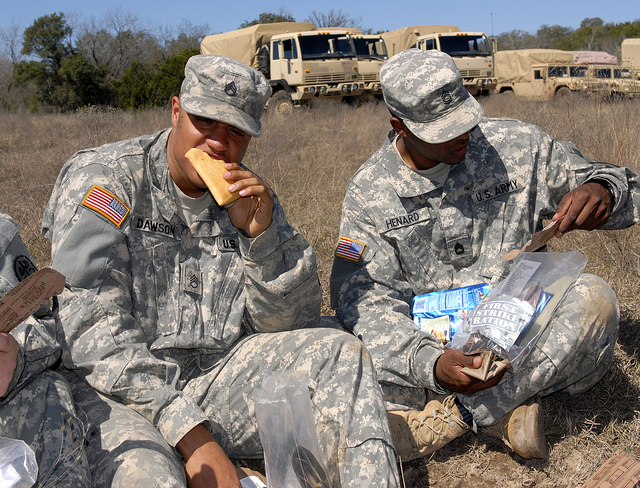Healthy Force, Healthy Nation

Maintaining a healthy lifestyle is partly dependent upon one's nutritional status. Unfortunately, Warfighters are continually subjected to pressures from obesogenic environments and dietary supplement marketing. These poor choices make it difficult for one to regulate personal body mass, maintain a proper balance of nutrients and, most troubling, access nutritionally valuable meals.
Twenty-first century Warfighters conduct battle tasks of varied duration and intensity in adverse environments containing multiple stressors. Due to these factors, it is difficult to determine how metabolic consequences of intense physical and cognitive effort, restricted replenishment of nutrients, fluids and sleep, and exposure to various climatic extremes influence the nutrient composition of rations provided during military missions. Novel nutritional strategies that enhance metabolic processes are required to sustain peak physical readiness at all times. In addition, these nutritional strategies, along with feeding plans and healthy weight management programs tailored for military effectiveness are critical. These are needed to promote effective training before deployments, enhance physiological recovery following redeployments, and support optimal garrison health between deployments.
Army research under the Military Operational Medicine Research Program takes a multifaceted approach, involving scientists from many specialties working together to understand and develop solutions to the Military's nutritional shortcomings. The research begins with the collection of descriptive data. These data are acquired during field studies that involve military units/personnel deployed, and in garrison training to document and characterize problems related to nutrition. Experimental models (human, animal, tissue, cell and molecular) are used to further elucidate the metabolic mechanisms underlying those problems and possible solutions. Based on mechanistic research findings, nutritional solutions are proposed, and initial efficacy tests are conducted using experimental human and animal models. Finally, fielded pilot studies are performed with the appropriate military populations to validate laboratory findings and demonstrate feasibility for implementation.
The scientific activities of this research exploit intramural resources and leverage extramural relationships with academia and industry. The products of the research are transitioned to customers who make operational rations (Combat Feeding Directorate, U.S. Army Natick Soldier RD&E Center, Natick, Mass.), produce educational materials (U.S. Army Public Health Command, Aberdeen Proving Ground, Md.), publish doctrine (U.S. Army Medical Department Center and School, San Antonio, Texas) that is used by all services and Department of Defense personnel, develop and implement health policy, and produce soldier materiel (PEO-Soldier).
A recent success of this directed effort is the First Strike Ration. The FSR is a lightweight ration that incorporates eat-on-the-move nutrient delivery systems and nutritionally optimized components. Research performed at the U.S. Army Research Institute of Environmental Medicine through the MOMRP has helped to develop the FSR in partnership with the NSRDEC Combat Feeding Directorate to meet the requirements of today's Warfighter on the asymmetrical battlefield, while also addressing the Future Force Warrior capability for a lightweight, efficient ration. In 2008, the FSR was validated to be nutritionally optimized, and it outperformed the current ration at that time. Although developed in 2008, the research to optimize rations continues, with the ideal ration being modified frequently to meet the emerging nutritional needs of the Warfighter.
Despite years of research to optimize the military ration so that it will contain the proper nutrients, Service members often supplement their food supplies. These supplements include vitamins, potential performance enhancing compounds, and many other manufactured dietary additives that have not been scientifically proven to produce the results promised by each. The Defense Health Program, under the DoD, supports an initiative known as the Center Alliance for Dietary Supplements Research. Its mission is to monitor the use, adverse events, as well as the safety and efficacy of the dietary supplements being used by the entire U.S. Military; examples of these supplements include Omega-3/fish oil, DMA, and caffeine. The CADSR provides research and information to support policy decisions and transition information regarding dietary supplements to the appropriate DoD elements, including the Office of the Secretary of Defense, Health Affairs, and the Service Surgeon Generals. As new supplements are advertised daily via the internet, Service members may be in danger of taking unsafe combinations of these commercially available dietary additives. Therefore, it is important that these men and women receive proper guidelines and educational materials regarding these products. The CADSR strives to inform Service members of the true efficacy of a variety of dietary supplements while also presenting to them the possible adverse events that could occur.
Future work in this area of Warfighter nutrition includes an in-depth study of Military dining facilities and their impact on eating behavior. Although healthy options are available in these facilities, a strong inclination exists for Service members to choose the less healthy and, theoretically, more appetizing sweets and fried choices. Through both education and modifying dining facility practices, it may be possible to promote healthy eating choices during military deployment and at home with family members. With the growing obesity epidemic, it remains critical to provide the most highly nutritional options for Warfighters en route to a proper healthy eating behavior. As the saying goes, "We are what we eat," and the optimal performance and operational success of our Military, and ultimately our nation, depends greatly on the healthy and safe nutritional practices of our Service members.














